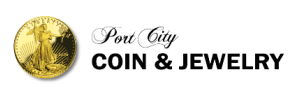Before 1965, the United States minted dimes, quarters and half dollars made of 90% silver and 10% copper. Starting in 1965, dimes and quarters have been minted in a copper and nickel clad composition with no silver content (other than Kennedy half dollars that were minted with 40% silver from 1965-1970).
Junk silver is different than most silver products in the market like silver bullion coins, rounds and bars that normally contain 99.9% silver and are minted in standard weights like 1/2 ounce, one ounce, five ounce, ten ounce and 100 ounce increments. This makes it easy to determine how much silver you are buying. For example, if you buy one five ounce silver bar and five one ounce American Silver Eagles, you can easily calculate that you are buying ten ounces of silver.
While pre-1965 dimes quarters and half dollars are made of 90% silver, the amount of silver is not easy to calculate when you are buying junk silver because the amount of silver in each coin is not denominated in round numbers.
For example:
Each pre- 1965 dime contains .07234 ounces of pure silver. Each dollar’s worth of pre-1965 dimes will contain .7234 ounces of silver (10 X .07234 = .7234 ounces)
Each quarter contains .18084 ounces of pure silver. Each dollar’s worth of pre- 1965 quarters will contain .72336 ounces of silver (4 X .18084 =.72336 ounces, rounded to .7234 ounces)
Each Half dollar contains .3619 ounces of pure silver. Each dollar’s worth of pre-1965 half dollars will contain .7238 ounces of silver (2X .3619=.7238 ounces)
Bullion dealers sell junk silver at a price per ounce over spot. In order to simplify pricing, dealers will often price junk silver sold by face value (as calculated off the spot price).
Calculating the Value of Junk Silver
The silver content for each of the dime, quarters and half dollars are the amounts contained in each coint at the time of mintage. During circulation of the coins, some of the silver content was inevitably lost due to constant handling. To compensate for this, dealers reduce the amount of silver in each dollar of face value from approximately .723 ounce to .715 ounces.
Here are two examples that calculate the value of junk silver using .715 ounces of silver per each dollar of face value.
If the spot price of silver is $15 an ounce, $1 dollar face value of silver dimes would contain about $10.73 worth of silver ($15 X .715= $10.725). Dealers will generally price their junk silver at the spot price of silver plus a fluctuating premium of say $1.00- $1.50 an ounce. If the spot price of silver is $15 and the premium is $1.00, the dealer will charge $11.73 per ounce of silver; if the premium charged is $1.50 an ounce the dealer will charge $12.23.
Therefore, $1 face value of silver dimes at $15.00 an ounce with a $1.00- $1.50 premium would cost $11.73 – $12.23.
If the spot price of silver is $20 an ounce, $1 dollar face value of silver dimes would contain about $14.30 worth of silver ($20 X .715= $14.30). Dealers will generally price their junk silver at the spot price of silver plus a fluctuating premium of say $1.00- $1.50 an ounce. If the spot price of silver is $20 and the premium is $1.00, the dealer will charge $15.30 per ounce of silver; if the premium charged is $1.50 an ounce the dealer will charge $15.80.
Therefore, $1 face value of silver dimes at $20.00 an ounce with a $1.00- $1.50 premium would cost $15.30 – $15.80.
The Junk Silver Coins
Dimes – Roosevelt Dimes (1946-1964), Mercury Dimes (1916-1945) and Barber Dimes (1892-1916)
Quarters – Washington Quarter (1932-1964), Standing Liberty Quarter (1916-1930), and Barber Quarter (1892-1916)
Half Dollars – Kennedy Half dollar (1964), Franklin Half Dollar (1948-1963) Walking Liberty Half Dollar (1916-1947)
Junk silver Standing Liberty Quarters, Barber Dimes and Quarters and older Mercury Dimes and Liberty Half Dollars generally show extreme wear.
Junk silver Roosevelt Dimes, Washington Quarters and Kennedy Half Dollars are easily recognizable as they have essentially the same design as dimes, quarters and half dollars in circulation today. As such, they are perfectly suited for barter should the need ever arise.
Silver Dollars – The Morgan (1878-1921) and Peace (1921-1935) silver dollar coins are priced seperately as they contain different amounts of silver. These coins contain .77344 ounces of silver vs. approximately .7234 ounce of silver found in pre-1965 dimes, quarters and half dollar. Morgan and Peace dollars will qualify as “junk” silver when sold as “cull dollars” which means they have been heavily circulated or contain other imperfections. These beautiful coins, however, are not widely recognized among those who are not coin collectors and sell at a greater, yet affordable, premium to junk dimes, quarters and half dollars.
Ask to see our inventory of Peace and Morgan Dollars.
Junk silver coins are not purchased for their numismatic value but rather for their silver content. Purchasing junk silver however, allows the silver investor to learn about United States coinage by sifting through the various designs, dates and mint marks of purchased dimes, quarters, half dollars and dollars.

Junk silver offers an affordable way to buy silver.
Visit Port City Coin & Jewelry
If you are in the New Hampshire Seacoast area, visit Port City Coin & Jewelry and ask about junk silver and our other services and specials. Or call 603-373-6185.

Port City Coin & Jewelry is located at 599 Lafayette Rd (Route 1) | Portsmouth, NH (next to Bowl O Rama)
Call: (603) 373-6185
email portcitycoin@gmail.com
Visit our web site: PortCityCoin.com

Be the first to comment on "How To Calculate Junk Silver Value"